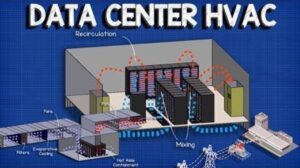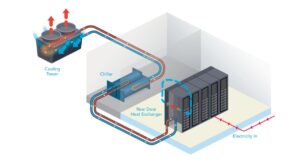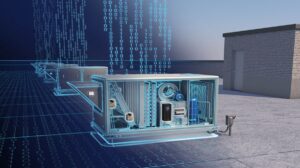Reliable HVAC systems are required in contemporary data warehouses, where high density racks of servers produce massive amounts of heat. If cooling is inadequate in data centers, it leads to equipment breakdown, service disruption, and expensive problems. Continued development of technology has meant that the current and future data centers have developed complex HVAC needs for cooling aligned with energy consumption and environmental responsibility and costs.
It becomes increasingly challenging for conventional cooling solutions to meet the data demands and thus the innovative technologies such as AI-controlled cooling, liquid cooling and the modular design solutions will have their way into data centers. The advances in these design elements hold great potential to change the face of data center cooling for optimal capacity utilization and dependable efficiency at high workload intensity.
Join us for more posts on how the trends are transforming the HVAC for data centers. Special emphasis will be placed throughout on how the industry is transitioning from traditional designs to energy-efficient solutions, and how integration of renewables is set to shape the architectural landscape of the future in line with the increasing digitization of the world’s economy.
The demand for Sophisticated HVAC in Data Centres

The contemporary data centers are important for the global interconnected web community: thousands of servers and related equipment, producing plenty of heat. Effective HVAC systems are important when deciding on temperature issues, reliable work, and equipment durability. Because of this change, HVAC solutions have increased their support to energy levels of demand, sustainability and scalability.
Such systems not only control cooling but also address energy consumption as well as facility operations. Since cooling contributes to almost seventy five percent of total energy utilization in data centers, HVAC innovation has emerged as critical. To serve these needs, data centers are investing in better, environmentally friendly HVAC systems that enhance efficiency and thus the environmental impact of data centers is lowered.
Liquid Cooling Technologies: A Game-Changer in Data Centers
One of the most effective HVAC advancements for data centers is liquid cooling. Unlike air cooling, liquid cooling directly uses water or coolants to dissipate heat from servers. This approach is ideal for high-density racks, as liquid’s superior thermal conductivity allows for better heat management. It also conserves energy by reducing the need for extensive airflow, lowering overall power consumption.
Liquid cooling is environmentally advantageous, as it enables water recycling within the system. This feature is particularly important for regions with strict energy regulations, driving data centers to implement compact, water-based cooling solutions. As data center densities increase, liquid cooling is poised to become a primary solution, addressing both cooling efficiency and sustainability goals.
Key Advantages of Liquid Cooling:
- Direct heat dissipation from server racks
- Improved efficiency for high-density configurations
- Reduced energy consumption compared to air cooling
AI-Powered Cooling Optimization

AI has transformed HVAC systems by enabling real-time monitoring and predictive maintenance. AI algorithms analyze temperature data, humidity, and server loads to adjust cooling levels automatically. This dynamic control reduces energy waste, cuts costs, and extends the lifespan of HVAC components, as AI-driven systems minimize temperature fluctuations.
In addition to efficiency, AI allows predictive maintenance. By identifying potential issues early, operators can prevent system failures that could disrupt data center operations. As AI technology advances, data centers can achieve more refined cooling optimization, which is crucial for facilities operating around the clock.
AI Benefits in HVAC for Data Centers:
| Feature | Benefit |
| Real-time monitoring | Optimizes cooling based on demand |
| Predictive maintenance | Prevents costly breakdowns |
| Cost-efficiency | Reduces unnecessary energy usage |
Procuring Sustainable HVAC and Certification terugplaatsen
To reduce environmental effects, data centers are spending on energy efficient HVAC which complies with LEED and ENERGY STAR guidelines. These certifications are oriented for the further development of the HVAC technology and dictate higher efficiency rates in cooling solutions. Energy efficient designs use properly designed controls, efficient drive techniques, and energy recovery ventilation to help lessen system energy consumption.
HVAC systems that have been accredited green are not only Eco-friendly but are also a bonus to the image of the data center. Having certifications, data centers provide services to environmentally-friendly clientele who are more likely to choose a vendor with a minimal environmental impact. This has brought a change towards sustainable HVAC trends to give a priority to energy-efficient cooling for competitive data centers.
Energy-Efficient HVAC Features:
- Advanced energy recovery for reduced consumption
- Variable speed drives to adjust cooling needs
- Improved air circulation with minimized resource usage
Modular and Scalable Cooling Systems for Flexibility

Single zone or modular HVAC systems are becoming more common because the systems are fairly easy to scale. These systems enable data centers to incorporate or de-incorporate cooling as activity levels rise and decline without bulky changes in infrastructure.. Each modular unit functions independently, making it easy to scale based on growth or workload requirements, which is ideal for colocation data centers with varying cooling needs.
Additionally, modular HVAC systems help reduce costs by enabling data centers to gradually increase cooling capacity as demand grows. This scalable approach also allows data centers to match cooling requirements to server density, avoiding unnecessary energy consumption and maximizing resource efficiency.
Benefits of Modular HVAC:
- Scalable cooling for flexible growth
- Cost-effective, incremental investment
- Dynamic cooling adaptation for optimal efficiency
Reusing Waste Heat and Energy Recovery Solutions
Heat recovery in data centers is becoming a valuable trend, with many facilities finding ways to repurpose waste heat. Instead of letting excess heat go unused, data centers can redirect it to nearby office buildings, homes, or thermal storage. This practice not only cuts down energy waste but also creates a circular economy by converting heat into a usable resource.
Some data centers use thermal energy storage to manage waste heat effectively. During peak cooling demand, stored heat can be recycled for use elsewhere, minimizing the reliance on external power sources. This approach saves costs, reduces emissions, and aligns with sustainability goals, making heat recovery an important aspect of future HVAC strategies.
Waste Heat Reuse Applications:
- Local building heating solutions
- Thermal energy storage for peak usage
- Reduced dependency on external power
Cooling Innovations for Edge Data Centers

With the rapid growth of edge computing, HVAC solutions are evolving to address unique cooling needs for distributed data centers. Edge data centers, which operate closer to end-users, require compact, efficient cooling solutions to maintain performance in diverse environments. Designed for remote management, edge cooling solutions are typically equipped with smart features, allowing monitoring and adjustments from a central location.
Edge cooling systems need to be resilient to all the challenges from weather conditions to fluctuating thermal loads and physical space constraints. To fulfill these needs, HVAC manufacturers are targeting built-in, efficient structures that align with edges’ decentralized infrastructure. It is perfectly natural for this trend to propagate when relying on more complex and still rather exotic, cooling solutions, catering to the decentralized computing of the modern age.
Edge Cooling Advantages:
- Compact design for space-constrained environments
- Remote management and monitoring capabilities
- Adaptability to diverse environmental conditions
Leveraging Renewable Energy for Sustainable HVAC
Its integration with HEVAC systems with renewable energy like solar and wind power are적인 reciprocation is also emerging. The use of renewable energy sources can cut carbon footprints as well as cost of operations and hence should be adopted by data centers that seek to embrace sustainable power systems. With energy costs increasing, using renewable energy sources to propel HVAC systems not only serves a sustainability purpose but also frees dependence on the conventional energy networks.
HVAC systems backed by renewables keep data centers operational during blackouts of grid power. This resilience makes data centers more sustainable, enabling greater growth throughout the years and following worldwide initiatives to decrease carbon emissions. In future designs, the incorporation of renewable energy will always be a common feature in HVAC systems for data centers.
Renewable HVAC Benefits:
- Reduces environmental impact and costs
- Ensures operational continuity during power outages
- Aligns with global sustainability standards
Conclusion
Trends of Federal Future HVAC for Data Center Cooling are identified as progressive, efficient, and environmentally friendly. Advances in the form of AI monitoring, liquid cooling, and modularity create agility and efficiency in energy for the higher density requirements as and when the need arises. All these technologies connect to current tendencies with minimum impacts on carbon emissions, it makes HVAC systems important leaders in sustainable data center approach.
Use of renewable energy sources as well as efficient waste heat recovery will add to the improvement of sustainability. These future trends in HVAC for data center cooling solutions means that the facilities can save and improve on their efficiency while fulfilling different environmental trends. ITmiddleware, these enhancements make data centers ready for the next digital break while staying in line with sustainable global initiatives.
FAQs
What is the future of data center cooling?
The future of data center cooling focuses on energy-efficient methods like liquid cooling, AI-driven systems, and renewable energy integration to meet growing sustainability demands.
What is the best cooling for data centers?
Liquid cooling is often the most effective for high-density data centers, as it directly removes heat from servers with minimal energy usage.
What are cooling strategies for data center?
Key strategies for efficiency and energy reduction include air economization, liquid cooling, hot/cold aisle containment, and free cooling.
What is the most common HVAC system used in data centers?
Precision air conditioning (PAC) units are often used for precise temperature, humidity, and airflow control in data centers.
What is the optimum cooling of data centers?
The ideal cooling range for data centers is 18°C to 27°C (64°F to 80°F) for equipment safety and energy efficiency.
Also Click on It: LINK











